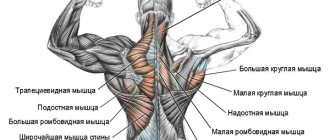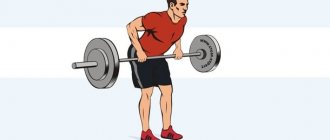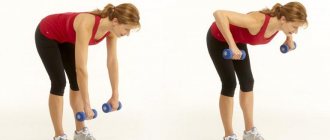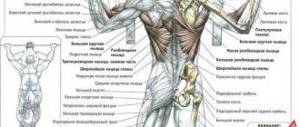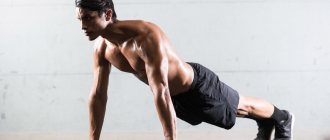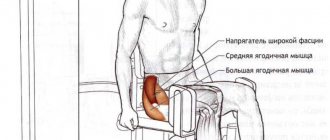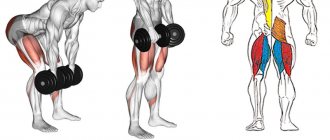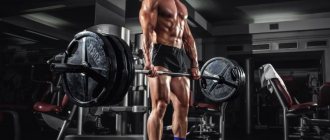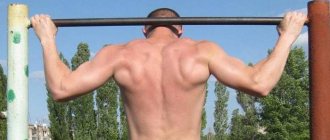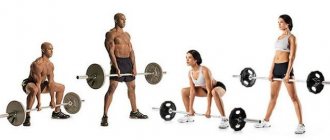Benefits of Exercise
Since two joints are involved in this exercise, the bent-over dumbbell row is considered a basic exercise or, as they say, a multi-joint exercise. The belt row is aimed at working several types of muscles at once; athletes perform it to increase muscle mass, the so-called pumping and, of course, to develop strength.
Among the advantages of bent-over waist rows is that it can be performed without exercise equipment, using dumbbells and a bench (and there is an option in a half-squat with emphasis on one leg without an elevation). It is only important to follow the basic rules and perform the exercise a sufficient number of times.
In addition, you should evaluate other advantages:
- The bent over row is a strength exercise. This requires the athlete to have sufficient strength and endurance.
- The exercise allows you to form a V-shaped figure, but thanks to the inclination and support, it does not overload the area of lordosis.
- The ability to perform a wider range of motion compared to a similar movement with a barbell.
- Also, bending over with a barbell allows you to focus your efforts on the back muscles. And if an athlete feels that his muscles are not developed symmetrically, he can even out the disproportion by performing more exercises with one hand than the other.
- The waist row does not overstrain the wrists, so there is no risk of injury.
- The load on the spine is not as strong as when working with a barbell.
If you're still thinking about whether to include dumbbell rows in your practice, learn about the benefits of this exercise so that you no longer doubt its effectiveness.
- Excellent load and safety at the same time. The exercise uses a huge muscle mass, but there is no load on the spine, as in the barbell row technique. This makes the practice suitable for those who have problems with the spine and lower back.
- A complex approach. In addition to directly affecting the back muscles, this technique helps strengthen the lower back, improve posture and help get rid of rounded shoulders.
- Relief back. Bent-over rows help you achieve a massive and beautiful V-shape of your back without the use of special machines.
- Possibility to do at home. The simplicity of sports equipment and the equipment itself allows you to do exercises at home. And if you haven’t gotten dumbbells yet, use plastic bottles filled with water or sand to start.
- posterior bundle of deltas;
- rhomboid muscles;
In addition, there are other reasons why many athletes prefer this exercise:
- No special equipment is required, so this exercise can be easily performed at home by replacing the dumbbell with a barrel of water.
- If you perform the bending exercise at different angles, you can work different areas of your back.
- Unlike the barbell row, in this exercise you can load one half of your back more. This situation is useful for those who have a pronounced asymmetry in the growth of the back muscles.
- Free weight exercises can be done by absolutely anyone, choosing the level of weight depending on your goals and fitness level.
- This exercise puts less stress on the lower back, so it is included in the training program for athletes with problems in the lower back.
There is another equally effective exercise aimed at training the back muscles. You can get acquainted with the technique of performing this exercise, as well as with all the nuances of training, in the article “Deadlift”.
Before analyzing the technique for performing dumbbell rows, it is worth familiarizing yourself with the recommendations for implementation, adhering to which, you will better master this exercise and minimize the risk of injury.
Features of the exercise
The dumbbell exercise has a lot in common with the bent-over barbell row. It also belongs to the category of basic, since several muscle groups, the shoulder and elbow joints are involved in its execution. During exercise, the latissimus, trapezius muscles, rear deltoids and biceps are tensed. The correct stance and execution technique ensure an emphasis on working out and stretching the back muscles. To do this, the effort is made by bringing the shoulder blades together, the elbow joint moves vertically, up and down without deviation from the axis of the spine. Inhale when lowering, exhale when the projectile is at the top point.
Modifications of the starting position allow you to vary the difficulty and select more gentle options using support. When doing bent-over rows while standing on both legs, they work with fairly large weights, obtaining a balanced development of the right and left areas of the back, static load of the abs and hamstrings. Changing the angle between the body and the shoulder joint transfers force from the deltoids to the muscles of the lumbar triangle. When the elbows are abducted, the deltoids are loaded; when positioned closer to the body, the rest of the back is loaded. The trajectory of movements is combined, achieving a balanced study of all zones.
Basic mistakes
During traction the following are involved:
- teres major muscles;
- back extensors;
- deltas;
- biceps;
- brachioradialis;
- trapezoidal;
- and rhomboid muscles.
This exercise is great for those who strive for pronounced relief and intensive growth of muscle mass.
Beginners should not focus on the scales and boast of strength next to the “fitness”. First, you need to master the correct technique for rowing a barbell in an inclined position, and only then increase the load, otherwise there is a risk of serious spinal injury.
Despite the fact that there are several variations of the exercise, the technique is essentially the same. The only difference is in the grip and equipment that the athlete uses during training. Benefits of standing bent over barbell row:
- improving posture and flexibility;
- increasing endurance;
- muscle strengthening and growth.
When performing this exercise, it is important to perform it as clearly as possible so that the triceps are involved. Therefore, it is unacceptable for the hand to deviate from the vertical position. For this purpose, you can hold it with your free hand by the triceps.
It should be remembered that the elbow cannot be bent more than 90 degrees. The back should be straight, the lower back should not arch.
And finally, don’t use dumbbells that are too heavy, it won’t do you any good.
The best exercises for arm muscles Choose your type of nutrition to achieve results faster!
As you already understand, you can work your back using one dumbbell or both at once. In this case, the body can be in different positions. You can stand on the floor, rest one knee on a bench, or even lie on an incline bench on your stomach. Hence the variety of exercise options.
All these exercises are aimed at developing the latissimus dorsi muscles. They are the ones who receive the greatest load when performed correctly. Additionally, the trapezius muscles, teres major, rhomboids and back extensors are involved (they fix the body in the desired position).
In addition to the back, some work is done by the rear deltoids, biceps and forearms.
We will consider the following exercise variations:
- One-arm dumbbell row or dumbbell row to the waist. This exercise is performed on a flat or incline bench and requires good stretching.
- Rowing two dumbbells while lying on an incline bench (analogous to the T-bar row exercise) at different angles.
- Standing bent over row. This is, in fact, an analogue of a bent-over barbell row.
With these three exercises you can effectively pump up your entire back.
Dumbbell rows allow you to work on:
- latissimus muscles;
- trapezoid;
- biceps;
- deltoid muscles;
- forearm.
It should be noted that the athlete should concentrate on lifting the weight exclusively by contracting the latissimus and teres major muscles, trying not to use other muscles.
Muscles working in the dumbbell row with one hand: 1 - latissimus dorsi; 2 - large round; 3 - trapezoidal; 4 - deltoid
When performing any exercise, you need to know which muscle groups are involved and how they work.
When done correctly, dumbbell rows are one of the best upper body tools in your training arsenal.
So what muscles are worked in this exercise? Mainly these are the latissimus and round muscles of the back, as well as the core.
The one-arm dumbbell row is great for those with back pain because it works the latissimus muscle, which is connected to the vertebrae of the thoracic, lumbar and sacral spine, as well as the sacroiliac joint. In addition, the exercise helps strengthen the muscles of the upper and middle back (which is difficult to achieve with deadlifts or squats alone), and also improves the mobility of the shoulder blades.
The bent-over dumbbell row also targets the rhomboids, lower trapezius, erector spinae, and requires good stabilization of the rotator cuff. This means that if you do the exercise correctly, you should feel the muscles between and under your shoulder blades working.
Basically, working from the dumbbells to the waist tightens the latissimus dorsi muscles. The following work as auxiliary ones:
- teres major muscles of the back;
- diamond-shaped;
- back extensor muscles, which hold the spine during the exercise.
The arm muscles are also tense:
- large posterior bundles of the deltoid muscle;
- muscles of the forearm;
- biceps.
Experienced fitness trainers note the importance of proper concentration during bent-over rows - you need to tense the teres major and latissimus dorsi muscles.
Despite the fact that the exercise is quite simple, it uses many muscles, namely:
- You need to immediately take a stable position to perform the deadlift.
- It is important to monitor your breathing - all efforts are made while exhaling, the moment of relaxation is while inhaling.
- If you can’t follow the technique, then it’s better to reduce the working weight. This will help hone the technical elements.
- There is no need to rush while doing the exercise; it should be done at a steady pace.
- During the training process, your back should be straight and slightly arched at the lower back.
- The stomach is tucked.
- You cannot arch your back or round your spine - this can lead to injuries and will not make the training effective.
- During a deadlift, only two joints work - the shoulder and elbow.
- You should not strain your arm muscles - some perform deadlifts solely using arm strength and thereby ruin the effect of the exercise.
- It must be remembered that the dumbbell row is performed vertically - the projectile should not follow a different trajectory.
- The spine should be positioned along the bench; you cannot stand unevenly, this will also interfere with training.
- There is no need to confuse the exercise with others with similar names: dumbbell rows while lying on an inclined bench, for example. This is a completely different exercise for a different muscle group. In this training you do not need to lie down, but stand on a bench.
- You don’t need to rely only on photos and videos when studying the training; it’s better to first contact an experienced trainer who will help in setting up the technique.
By observing all these conditions, you can achieve excellent results in working out the back muscles.
Benefits and disadvantages
The exercise is energy-intensive and can develop the strength and volume of most back muscles. It will also be an excellent exercise for home training for both men and women. When performing deadlifts, not only the back muscles are used, but also the core stabilizers. This type of row can also be performed while standing on an incline bench, which provides the most stable position, reducing the load and the possibility of injury.
By changing the hold of the dumbbells (pressing your elbows to your body or like a barbell, spreading your elbows to the sides), you can change the emphasis of the load on one or another area of the back.
- When posing with elbows apart, the load falls on the trapezius, teres major and minor muscles, the back of the deltoids, and, of course, the rhomboids and latissimus dorsi muscles.
- When the elbows are pressed to the torso, the rhomboid and latissimus muscles receive the maximum load, while the rest of the muscles receive less load.
The disadvantage of rowing to the belt is the load on the spine; by the way, some athletes with injuries will not be able to perform this exercise at all. But the emphasis lying on an inclined bench or the T-bar row in an emphasis position is a completely different matter. This option will suit almost everyone.
Recommendations for implementation
By following these recommendations, you will see and feel the results of the exercise faster.
- It is best to do 8-10 repetitions on each arm for the first three weeks of training, then move on to 10-15, the number of sets (approaches) 3-4 times.
- You need to introduce it into your training a little earlier than the middle of the complex for the latissimus dorsi muscles.
- Bodybuilding instructors recommend starting practice with a weaker arm for the harmonious development of your body.
- Perform at a slow pace, pausing at the end points for a few seconds, holding your breath, and up to 2 minutes between sets.
- Try to make your first effort powerful. Otherwise, you may not be able to raise your elbow higher than your shoulder, and therefore you will not achieve the full contraction of the back muscles involved in this exercise.
- While raising the working shoulder, do not lower the opposite one. Try to pull your shoulder higher while keeping your back motionless.
- If you cannot raise your elbow higher than your shoulder, it is better to take a dumbbell that is less heavy. Remember that the higher your elbow is above your shoulder, the more powerful your back muscles contract.
- Keep your body parallel to the floor, as rounding your back is dangerous.
- Try to pull the dumbbell using your shoulder and back muscles without straining your biceps.
- For convenience, alternate performing exercises with your leg on the floor or on a bench,
It’s quite easy to work different muscles in the waist row by simply changing the angle formed by the line of the body and the line of the shoulder. There are three main options:
- By moving the elbow away from the body a considerable distance, the athlete transfers the main load to the posterior bundle of the deltoid muscle.
- By pressing the elbow to the body, the athlete tightens the latissimus dorsi muscle more strongly.
- In the middle position, the teres major and rhomboid muscles will work.
Two options are recognized as the most effective: with the elbows at the body and with the elbow wide apart.
It is equally important to point the dumbbell towards your waist, in the area between your waist and diaphragm.
Experienced trainers also recommend paying attention to some details:
- At the beginning of lifting your arm, apply more force - your goal is to lift the load as high as possible.
- Do not lower your free shoulder when lifting a load.
- If you can’t lift the dumbbell high, it means you took on too much weight.
- Don't forget to warm up before training. Muscles require pre-warming before starting to lift weights.
- Perform the exercise up to 20 times in 3-4 approaches. Rest 30–60 seconds between sets.
- Choose the right weight. The main condition is to perform the required number of repetitions technically correctly.
- Do not make sudden jerks.
- Fix the position of the body, do not turn in the lower back.
- Direct your gaze forward so that there is no temptation to lower your head and round your back. Also, the cause of a “round” back can be too much weight.
- Depending on the position, dumbbell rows can be performed standing or resting on a bench.
Today we will look at the second option.
Execution step by step
Despite the fact that the bent-over row looks very simple, it must be performed in accordance with certain rules:
- Choose dumbbells that are the right weight for you - after 10 repetitions, your back muscles should feel a significant amount of tension, but not too much. In a minute you should be ready for the second set.
- Stand sideways to the bench, rest your knee on one leg and rest with one hand. The hip joint should form an angle of 90 degrees. Your body and the bench should be in a parallel position.
- Straighten your back, bend at the waist, look forward.
- Inhale and as you exhale, begin moving your arm with the dumbbells. Keep the dumbbell bar parallel to your body.
- Raise your arm, bending it at the elbow to a right angle.
- At the top, bring your elbow above your body without turning your back. This will cause your muscles to contract more strongly.
- Pull the dumbbell back a little.
- At the top point, fix the position for a few seconds.
- As you inhale, lower your hand down.
Variations of this exercise
There are two main variations of this exercise, which can be alternated during the approach in order to make your workout more comfortable.
When you have mastered the technique of the classic alternating dumbbell row on a bench, you can move on to its various variations. By sticking with just one exercise, you increase your risk of getting repetitive injuries (think long-distance runners and their hip injuries), or at least reaching a plateau.
By making small changes to your body position or grip, you can continue to stimulate the growth of new muscle fibers and give them new stimulus to adapt.
Holding dumbbells at different points on the handle causes the forearm muscles to work differently, which affects your ability to stabilize the weight.
Changing the position of the legs and hips provides different bases of support and also changes the position of the pelvis and spine, which affects the ability of the muscles to perform the pulling movement. These small adjustments to the exercise can lead to great results.
Common Mistakes
Inaccuracies in technique lead to a decrease in the effectiveness of training. In addition, some inconsistencies during execution are dangerous for the joints or spine. It is necessary to reduce the weight of the dumbbells and change the modification of the exercise if the following signs are noted when performing deadlifts:
- there is not enough strength for a full lift, the hand with the projectile moves only half the amplitude;
- the beginning of the pull is performed with a jerk, the biceps muscles working at the moment of start indicate a shift of the load from the desired muscle zones;
- “round”, the back is hunched, which means there is not enough stretching - it is worth considering the option of an incline bench;
- the head is tilted forward, which violates the anatomical position of the spine and creates a risk of pinching;
- The dumbbells are pulled to the chest, not to the stomach.
If the technique is followed, then after training the athlete feels fatigue in the muscles between and under the shoulder blades. During training, the athlete concentrates on the correct distribution of muscle work; the biceps and arm flexors should be minimally loaded. Only in this way will dumbbell rows give the desired result and become a key exercise for strengthening the back.
Beginners and experienced athletes regularly perform bent-over dumbbell rows. The classic base is modified for different levels of training, performed with small and large weights. This is a great way to get a balanced, developed back, work the latissimus muscles and improve your posture.
Who should do it?
Bent-over rows are a great exercise for anyone who wants to pump up their back muscles, increase their strength and achieve beautiful definition. This exercise cannot be called difficult; it is easily mastered by beginners in fitness and performed by experienced athletes:
- Beginners should focus on technique.
- For experienced athletes, increase the weight of the load and the number of repetitions.
In women's training, deadlifting is not considered the main exercise, but it must be done, since deadlifting strengthens the back muscles, forms its beautiful curve and prevents the deposition of fat under the skin. The belt row is part of the complexes for women, including this exercise, which is performed even in the strength part of aerobics training.
Experts in the field of healthy lifestyle claim that people who spend a lot of time in offices and lead a sedentary lifestyle usually “earn” scoliosis, that is, a curvature of the spinal column. Knowing his diagnosis and understanding how the imbalance developed, a person can help himself cope with the problem by performing dumbbell rows.
Technique for performing bent-over dumbbell rows
This option can be performed either standing or lying on your stomach on an inclined bench. You can hold the dumbbells parallel to your body, or you can have their bars resemble the bar of the barbell you are holding. Do what is most convenient for you.
The exercise can be performed not only in the gym, but also at home, since the technique for performing it is very simple.
- Hold a dumbbell in your right hand with your palm facing the side of your thigh. Stand to the left of the bench.
- Take your starting position: your back is slightly arched in the lower back, your body is parallel to the floor.
- The right arm is straight, and the right shoulder is slightly lowered.
- As you inhale, lift the dumbbell up as high as possible.
- The moment your elbow is level with your shoulder, begin to raise your shoulder as well. This promotes better contraction of the back muscles.
- Try holding the dumbbell for a few seconds at the top. Exhale and calmly lower the dumbbell.
You can get acquainted with another, no less effective exercise for working the back muscles in the article “Pulldown of the upper block behind the head.”
After watching the video, you will learn how to properly do bent-over dumbbell rows. The instructor demonstrates the correct and incorrect methods of execution, so that you are sure to use the right muscle groups in your training and get the desired result.
Now you are familiar with the basic exercise for the back muscles, which, with regular practice, will make your back sculpted and strong. This technique is performed without putting stress on the spine, and therefore is suitable even for beginners. The ease of implementation and sports equipment makes it possible to practice even at home.
If you ask a dozen people at the gym where they feel tension when doing dumbbell rows, they will point to the elbow, biceps, wrists, shoulders, neck, glutes and other parts of the body, but not the lats.
Perhaps it is precisely because of incorrect body position that people subsequently begin to complain of back pain. They mistakenly round the thoracic or lumbar spine, tilt their head too low or, on the contrary, throw it back, place their elbows to the sides, turn their wrists, twist their torso, or jerk the dumbbell.
The position of the spine affects the movement of the shoulders. Since the latissimus dorsi muscles move the shoulder blades, the pulling motion will only be correct if the upper back is not rounded.
Rounding the back limits the mobility of the shoulder blades and eliminates the ability to engage the latissimus muscles.
Many people also pull the dumbbell too high, which seems like a good idea when counteracting gravity. But in this case, look at the position of the body: the latissimus muscle is below the shoulder, and the upper part of the trapezius muscle and the levator scapula muscle are above it.
This means that the one-arm dumbbell row will engage the upper trapezius and levator scapulae muscles rather than the latissimus and rhomboids.
The shoulder blades should be tense and pressed against the back, and the dumbbell should be raised to the level of the upper thigh.
Many people, when performing a dumbbell row with one arm while standing on an incline, also turn their torso to the side and extend their leg at the knee. The exercise begins to somewhat resemble a leg press with a weight in one hand.
The body should be absolutely motionless, and movement should come only from the arm and shoulder.
The latissimus muscles act as spinal extensor muscles and are also responsible for fixing the shoulder blades, so a straight back position will allow them to be used more actively.
Many people, instead of tensing their core muscles, tense their abdominal muscles, which causes them to involuntarily pull their pelvis back and, as a result, arch their spine. You shouldn't do this.
And finally, the last mistake concerns incomplete engagement of the shoulder blades, which leads to a decrease in the load on the rhomboid muscles and trapezius.
The back position here is correct, but the shoulder blades are not tense enough to do their job. This is similar to a dumbbell biceps curl with the arms not fully extended. Of course, the muscles still work, but this is far from ideal.
The cause may be immobility of the front of the shoulder, particularly the clavicular head of the pectoralis major and pectoralis minor muscles, as well as weakness of the rhomboid muscles. Often a little stretching can improve the position and increase your range of motion.
Place your knee and shin on a horizontal bench. Bend your body until it is parallel to the floor, resting your free hand on the bench. Take a dumbbell in your working hand with a neutral grip. Raise your chin and look forward.
Create a natural arch in your lower back. Maintain this body position until the end of the exercise. As you exhale, lift the dumbbell to your waist. In this case, the elbow tends upward and passes close to the body. As you inhale, lower the dumbbell down.
Despite the fact that the exercise seems very simple at first glance, there are a lot of mistakes that beginners make during training. We advise you to familiarize yourself with these errors in order to focus your attention on the correct execution of the exercise.
From this video you will learn about all the nuances of the exercise, clearly see the execution options, and also become familiar with common mistakes during training.
Today you got acquainted with one of the most effective exercises for the back muscles. Do not forget that to achieve your goal, not only the correct technique is important, but also the regularity of training.
Do you use this exercise to work on your back muscles? In what version do you perform it? Tell us about your successes and impressions in the comments.
Common mistakes
- dumbbell rows using the biceps rather than the forearm and back muscles;
- lumbar rotations;
- flexion of the spine in the form of the letter “C”;
- abduction of the elbow to the side;
- jerks in movements;
- lowering of the pelvis and head too low;
- high elevation of the pelvis and head.
Most often, beginners make several mistakes.
- Performing exercises with heavy weights without a bench. A large weight immediately overwhelms an athlete, even if he is very strong. The additional load has to be compensated by stabilizer muscles. As a result, the body loses stability, and this is fraught with injury.
- Haste. It appears if the weight of the dumbbell is insufficient. Jerks lead to inertia, inertia reduces the effectiveness of the exercise.
- Rotation of the body, lowered head and rounded back. Both errors are unacceptable.
- The dumbbell rises to the chest. This happens when an athlete overestimates his capabilities and lifts too much weight.
Accordingly, we can conclude that bent over rows should be performed:
- with the correct weight;
- slowly, controlling all the muscles involved in the work;
- clearly fix the position of the body.
- Shoulder collapse at the lowest point. As already mentioned, the position of the body must be fixed strictly parallel to the floor.
- Rotation of the body at the waist at the top point. In this case, the lower back receives a large load, and the target muscles do not work.
- Rounding the back. To avoid this problem, keep your chin up and choose the right weight.
- Raising a dumbbell using the muscles of the arm. Here it is important to focus your attention on the work of the target muscles. You should clearly feel the work of the latter.
- Raising your elbows to the side. To maximally engage the target muscles, raise your elbow as high as possible and do not pull it to the side.
To finally understand the technique, we suggest you watch the following video.
Each exercise has its own nuances and subtleties of implementation. The dumbbell row is no exception. Moreover, we are dealing with back training. Therefore, there are a lot of nuances here. To ensure that your training is as productive as possible, and, most importantly, does not injure you, try to avoid the following mistakes:
- Rotating your back is dangerous for your spine. The movement should be carried out by lifting the shoulder blade, and not by rotating the back.
- Rounding your back is a serious mistake when performing any exercise. Especially here, such a mistake can be disastrous. After all, when performing an approach, your lower back receives a static load, and rounding your back can lead to injury to the vertebrae.
- Moving your elbow to the side is a mistake that will get you nowhere. That is, neither to injury nor to the desired result. If you move your elbow to the side, your biceps and rear deltoids will work actively. We don't need them here, because we're shaking our backs.
- Movement in a short amplitude will reduce the effectiveness of your workout. In order to pump the back muscles well, it is necessary that at the top point the elbow is higher than shoulder level.
- Lowering the inactive shoulder. While performing the deadlift, your back should be motionless. If you raise one shoulder at the expense of lowering the other, the exercise will not benefit you. You will simply waste your energy on something unknown.
Mistakes during the exercise
The main mistakes when performing bent-over dumbbell rows:
- “Nod” or lower your head . If an athlete tucks their chin toward their chest, it creates unnecessary tension in the cervical spine, which can lead to injury. With your head down, it is difficult to stretch the weight due to muscle strength; many use inertia;
- The dumbbell moves not to the belt, but to the chest . This means that a lot of extra muscles are involved - the arm is too bent at the elbow joint, the athlete does not control the work of the lats, but pulls exclusively with a jerk. Sometimes you can see how athletes move their forearm perpendicular to the axis of the spine and support themselves using the posterior deltoid muscle. If this is not done intentionally, then it should be understood that the load is removed from the back;
- The weight rises with a jerk . Too high a pace and strong pushing of the feet off the floor are the main reasons why an athlete cannot effectively work out the muscles. It can also cause injury if the weight is too heavy. Most often, with this technique, spasm of the trapezius muscle occurs, its overload, as well as pain in the trapezius, neck and back of the head;
- Round back . This option is the reason for the lack of stability in the lumbar spine. This can lead to serious injury and the athlete losing control of their body position. The round back option “works” mainly the biceps and trapezius, so it should be abandoned. If your back turns out to be round, then you should try a higher support;
- Start with the biceps . This movement almost completely eliminates the work of the back. It “steals” the load from the rhomboid muscles and leads to the fact that the athlete only pumps his arms. To get rid of the problem, it is recommended to focus on the shoulder blade towards the spine. You can think of your hand as a support that simply supports the weight.
Contraindications
In some cases, bent-over rows of dumbbells are contraindicated, since horizontal rows put a load on the spinal column. If an athlete has spinal diseases such as hernia, hyperlordosis or hyperkyphosis, then he should give up deadlifting.
Contraindications are also related to the rules for performing exercises. If they are violated, injuries are possible.
Bent-over dumbbell rows are a good exercise that can be part of a training complex for athletes of any level. The rules of this exercise are quite simple, and several execution options will help you choose the most effective option for each athlete.
Exercise options
There are several variations of the exercise, but usually there are two main types:
- The first type is when the athlete puts his knee on a horizontal bench, while resting his hand on it, slightly bent at the elbow. The body is almost in a parallel position relative to the floor. The dumbbell lies on the floor under your left hand. The left leg is almost straight and set back and slightly to the side.
- In the second option, the athlete rests on the bench with only his hand. The knee is on the floor. That is, you need to bend your right leg quite strongly and put it in front of your left leg. The left leg is kept almost straight. The torso is parallel to the floor.
Watch 2 options for performing the exercise on video.
The first open-air gym was formed in 1824 in the USA, Massachusetts. There, children were trained in the first school gymnastics program.
